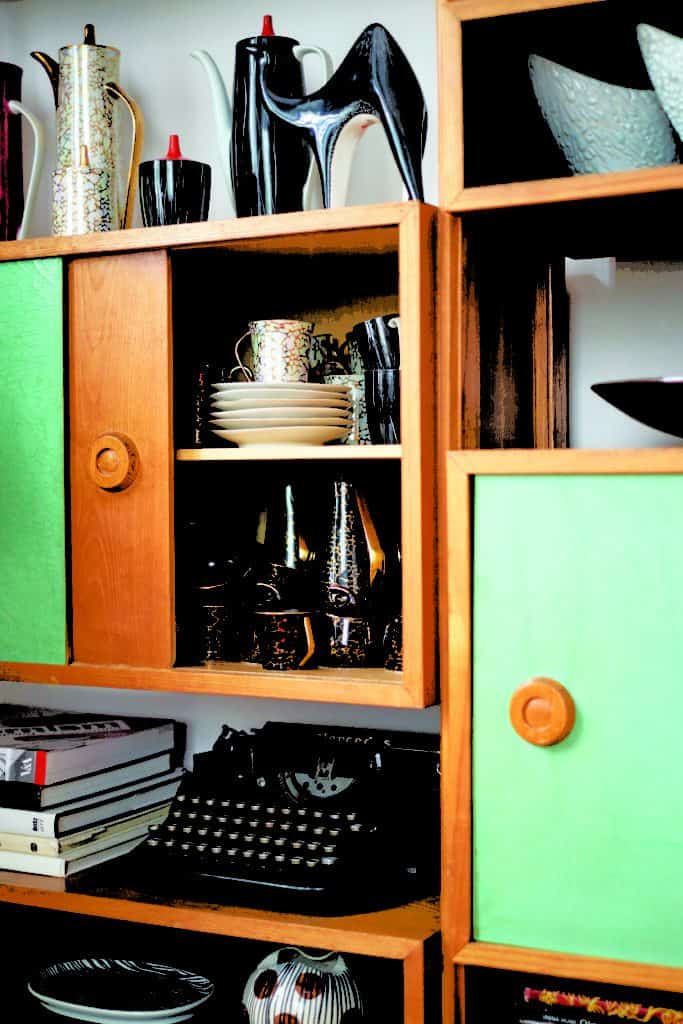
Bookcase, 60s., designed by Rajmund Hałas, Bydgoska Fabryka Mebli, wood, glass, photo Max Zieliński, Eliza Dunajska
A ray of enthusiasm (on the positive hype surrounding Hałas)
The history of Polish post-war design has a certain amount of drama attached to it. Whether we like it or not being a creative in Soviet Poland meant facing obstacles of not only ideological but also pragmatic matters. Your project won a prize during an important exhibition, but the economy was inefficient in turning it into a mass product. If you were lucky and got the contract, it was highly possible the pieces you designed were sell-only on export. On the top of all that, even if your furniture or tableware became popular in the country, your name was usually unknown because there was no tradition or will of celebrating designers. These are just a few of the many problems that result in the fact that we learn the history of Polish design from books, old catalogues and museum collections instead of experience (I guess the Czechs were equally unlucky in that department).
A multifunctional bookstand by Rajmund Hałas (circa 1961), shares the same faith as many progressive Polish projects from the late 50s and the 60s. A light construction with beautiful proportions, featuring customisable shelves and attractive yet elegant colours (different combinations of natural wood with black, blue, red and pistachio accents). The bookstand was made out of solid wood and produced with care to detail at Bydgoskie Fabryki Mebli (the Furniture Factories in Bydgoszcz), a company established in the 1800s. For years the piece by Hałas has been one of the best sellers outside of Poland. People from Denmark and Germany were buying them under different brands, unaware that the bookstand was made over on the other side of the iron curtain.
The history of Polish post-war design has a certain amount of drama attached to it.
Whether we like it or not being a creative in Soviet Poland
meant facing obstacles of not only ideological but also pragmatic matters.
Learning this fact might be one of the many proofs that modernism was truly the last universal style, which echoes through decades to this day. But the shape of Hałas’ piece also reflects the period in which it was created. Before the Second World War, there were no solid examples of modern style in Polish design. The government was trying to encourage new fashions and to be up-to-date with the rest of the world through some public commissions, but before the seeds had a chance to grow, the war started. The professors educating the first post-war students had the highest pre-war standards and minds still full of progressive attitudes. Now designers had to face new challenges like small apartments and petty-bourgeois tastes (and believe me when I say that old habits die hard, especially in stubborn Polish society). Functionality, simplicity, cheap production – these were the slogans to go with. After October 1956, which is known as the “Polish thaw”, creatives felt freer to experiment and work with new materials. They had a freedom to be inspired by the movements such as the Bauhaus.
Is this the reason, why Rajmund Hałas used cheerful colours on the panels of his bookstand or to show a ray of enthusiasm? Most likely – we will never know. History has not done its homework on Hałas and his motives just yet, the sources are poor, although his projects are getting more and more recognition thanks to passionate individuals: Polish Facebook is boiling with groups that share any knowledge they can get. Plus the bookstand has been the star of last year’s book cover of a bestseller by Beata Bochińska, historian of art and design lover, who wrote in simple words how collecting design is pure fun. Last but not least, this summer the University of the Arts Poznań –UAP (where Hałas received his education) prepared an exhibition on the designer from a series exploring important creators associated with the UAP.
With all that fuss and an upcoming permanent exhibition of Polish design in the National Museum in Warsaw opening this autumn, this might be the last chance to hunt down your own Hałas before the prices get crazy. Perhaps instead of purchasing new blazers you could get your blood pumping while bidding for an elegant bookstand from the 60s? I know I would.

Bookcase, 60s., designed by Rajmund Hałas, Bydgoska Fabryka Mebli, wood, glass, photo Max Zieliński, Eliza Dunajska








